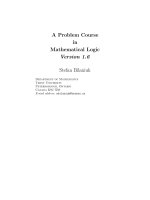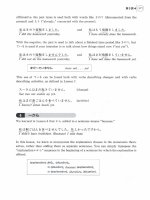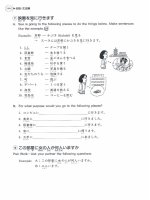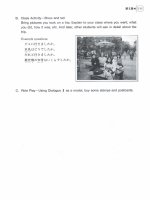A Course in Mathematical Statistics phần 1 ppt
Bạn đang xem bản rút gọn của tài liệu. Xem và tải ngay bản đầy đủ của tài liệu tại đây (347.73 KB, 58 trang )
Contents i
A Course in Mathematical Statistics
Second Edition
ii Contents
This Page Intentionally Left Blank
Contents iii
ACADEMIC PRESS
San Diego
•
London
•
Boston
New York
•
Sydney
•
Tokyo
•
Toronto
A Course in Mathematical Statistics
Second Edition
George G. Roussas
Intercollege Division of Statistics
University of California
Davis, California
iv Contents
This book is printed on acid-free paper. ∞
Copyright © 1997 by Academic Press
All rights reserved.
No part of this publication may be reproduced or transmitted in any form or by
any means, electronic or mechanical, including photocopy, recording, or any
information storage and retrieval system, without permission in writing from the
publisher.
ACADEMIC PRESS
525 B Street, Suite 1900, San Diego, CA 92101-4495, USA
1300 Boylston Street, Chestnut Hill, MA 02167, USA
ACADEMIC PRESS LIMITED
24–28 Oval Road, London NW1 7DX, UK
/>Library of Congress Cataloging-in-Publication Data
Roussas, George G.
A course in mathematical statistics / George G. Roussas.—2nd ed.
p. cm.
Rev. ed. of: A first course in mathematical statistics. 1973.
Includes index.
ISBN 0-12-599315-3
1. Mathematical statistics. I. Roussas, George G. First course in mathematical
statistics. II. Title.
QA276.R687 1997 96-42115
519.5—dc20 CIP
Printed in the United States of America
96 97 98 99 00 EB 9 8 7 6 5 4 3 2 1
Contents v
To my wife and sons
vi Contents
This Page Intentionally Left Blank
Contents vii
vii
Contents
Preface to the Second Edition xv
Preface to the First Edition xviii
Chapter 1 Basic Concepts of Set Theory 1
1.1 Some Definitions and Notation 1
Exercises 5
1.2* Fields and
σσ
σσ
σ
-Fields 8
Chapter 2 Some Probabilistic Concepts and Results 14
2.1 Probability Functions and Some Basic Properties and Results 14
Exercises 20
2.2 Conditional Probability 21
Exercises 25
2.3 Independence 27
Exercises 33
2.4 Combinatorial Results 34
Exercises 40
2.5* Product Probability Spaces 45
Exercises 47
viii Contents
2.6* The Probability of Matchings 47
Exercises 52
Chapter 3 On Random Variables and Their Distributions 53
3.1 Some General Concepts 53
3.2 Discrete Random Variables (and Random Vectors) 55
Exercises 61
3.3 Continuous Random Variables (and Random Vectors) 65
Exercises 76
3.4 The Poisson Distribution as an Approximation to the Binomial
Distribution and the Binomial Distribution as an Approximation to the
Hypergeometric Distribution 79
Exercises 82
3.5* Random Variables as Measurable Functions and Related Results 82
Exercises 84
Chapter 4 Distribution Functions, Probability Densities, and Their
Relationship 85
4.1 The Cumulative Distribution Function (c.d.f. or d.f.) of a Random
Vector—Basic Properties of the d.f. of a Random Variable 85
Exercises 89
4.2 The d.f. of a Random Vector and Its Properties—Marginal and
Conditional d.f.’s and p.d.f.’s 91
Exercises 97
4.3 Quantiles and Modes of a Distribution 99
Exercises 102
4.4* Justification of Statements 1 and 2 102
Exercises 105
Chapter 5 Moments of Random Variables—Some Moment and
Probability Inequalities 106
5.1 Moments of Random Variables 106
Exercises 111
5.2 Expectations and Variances of Some R.V.’s 114
Exercises 119
5.3 Conditional Moments of Random Variables 122
Exercises 124
Contents ix
5.4 Some Important Applications: Probability and Moment
Inequalities 125
Exercises 128
5.5 Covariance, Correlation Coefficient and Its Interpretation 129
Exercises 133
5.6* Justification of Relation (2) in Chapter 2 134
Chapter 6 Characteristic Functions, Moment Generating Functions
and Related Theorems 138
6.1 Preliminaries 138
6.2 Definitions and Basic Theorems—The One-Dimensional Case 140
Exercises 145
6.3 The Characteristic Functions of Some Random Variables 146
Exercises 149
6.4 Definitions and Basic Theorems—The Multidimensional Case 150
Exercises 152
6.5 The Moment Generating Function and Factorial Moment Generating
Function of a Random Variable 153
Exercises 160
Chapter 7 Stochastic Independence with Some Applications 164
7.1 Stochastic Independence: Criteria of Independence 164
Exercises 168
7.2 Proof of Lemma 2 and Related Results 170
Exercises 172
7.3 Some Consequences of Independence 173
Exercises 176
7.4* Independence of Classes of Events and Related Results 177
Exercise 179
Chapter 8 Basic Limit Theorems 180
8.1 Some Modes of Convergence 180
Exercises 182
8.2 Relationships Among the Various Modes of Convergence 182
Exercises 187
8.3 The Central Limit Theorem 187
Exercises 194
8.4 Laws of Large Numbers 196
Exercises 198
x Contents
8.5 Further Limit Theorems 199
Exercises 206
8.6* Pólya’s Lemma and Alternative Proof of the WLLN 206
Exercises 211
Chapter 9 Transformations of Random Variables and Random
Vectors 212
9.1 The Univariate Case 212
Exercises 218
9.2 The Multivariate Case 219
Exercises 233
9.3 Linear Transformations of Random Vectors 235
Exercises 240
9.4 The Probability Integral Transform 242
Exercise 244
Chapter 10 Order Statistics and Related Theorems 245
10.1 Order Statistics and Related Distributions 245
Exercises 252
10.2 Further Distribution Theory: Probability of Coverage of a Population
Quantile 256
Exercise 258
Chapter 11 Sufficiency and Related Theorems 259
11.1 Sufficiency: Definition and Some Basic Results 260
Exercises 269
11.2 Completeness 271
Exercises 273
11.3 Unbiasedness—Uniqueness 274
Exercises 276
11.4 The Exponential Family of p.d.f.’s: One-Dimensional Parameter
Case 276
Exercises 280
11.5 Some Multiparameter Generalizations 281
Exercises 282
Chapter 12 Point Estimation 284
12.1 Introduction 284
Exercise 284
Contents xi
12.2 Criteria for Selecting an Estimator: Unbiasedness, Minimum
Variance 285
Exercises 286
12.3 The Case of Availability of Complete Sufficient Statistics 287
Exercises 292
12.4 The Case Where Complete Sufficient Statistics Are Not Available or
May Not Exist: Cramér-Rao Inequality 293
Exercises 301
12.5 Criteria for Selecting an Estimator: The Maximum Likelihood
Principle 302
Exercises 308
12.6 Criteria for Selecting an Estimator: The Decision-
Theoretic Approach 309
12.7 Finding Bayes Estimators 312
Exercises 317
12.8 Finding Minimax Estimators 318
Exercise 320
12.9 Other Methods of Estimation 320
Exercises 322
12.10 Asymptotically Optimal Properties of Estimators 322
Exercise 325
12.11 Closing Remarks 325
Exercises 326
Chapter 13 Testing Hypotheses 327
13.1 General Concepts of the Neyman-Pearson Testing Hypotheses
Theory 327
Exercise 329
13.2 Testing a Simple Hypothesis Against a Simple Alternative 329
Exercises 336
13.3 UMP Tests for Testing Certain Composite Hypotheses 337
Exercises 347
13.4 UMPU Tests for Testing Certain Composite Hypotheses 349
Exercises 353
13.5 Testing the Parameters of a Normal Distribution 353
Exercises 356
13.6 Comparing the Parameters of Two Normal Distributions 357
Exercises 360
13.7 Likelihood Ratio Tests 361
Exercises 369
13.8 Applications of LR Tests: Contingency Tables, Goodness-of-Fit
Tests 370
Exercises 373
xii Contents
13.9 Decision-Theoretic Viewpoint of Testing Hypotheses 375
Chapter 14 Sequential Procedures 382
14.1 Some Basic Theorems of Sequential Sampling 382
Exercises 388
14.2 Sequential Probability Ratio Test 388
Exercise 392
14.3 Optimality of the SPRT-Expected Sample Size 393
Exercises 394
14.4 Some Examples 394
Chapter 15 Confidence Regions—Tolerance Intervals 397
15.1 Confidence Intervals 397
Exercise 398
15.2 Some Examples 398
Exercises 404
15.3 Confidence Intervals in the Presence of Nuisance Parameters 407
Exercise 410
15.4 Confidence Regions—Approximate Confidence Intervals 410
Exercises 412
15.5 Tolerance Intervals 413
Chapter 16 The General Linear Hypothesis 416
16.1 Introduction of the Model 416
16.2 Least Square Estimators—Normal Equations 418
16.3 Canonical Reduction of the Linear Model—Estimation of
σσ
σσ
σ
2
424
Exercises 428
16.4 Testing Hypotheses About
ηη
ηη
η
==
==
=
E
(Y) 429
Exercises 433
16.5 Derivation of the Distribution of the F Statistic 433
Exercises 436
Chapter 17 Analysis of Variance 440
17.1 One-way Layout (or One-way Classification) with the Same Number of
Observations Per Cell 440
Exercise 446
17.2 Two-way Layout (Classification) with One Observation Per Cell 446
Exercises 451
Contents xiii
17.3 Two-way Layout (Classification) with
K
(
≥≥
≥≥
≥ 2) Observations
Per Cell 452
Exercises 457
17.4 A Multicomparison method 458
Exercises 462
Chapter 18 The Multivariate Normal Distribution 463
18.1 Introduction 463
Exercises 466
18.2 Some Properties of Multivariate Normal Distributions 467
Exercise 469
18.3 Estimation of
μμ
μμ
μ
and
ΣΣ
ΣΣ
Σ
//
//
/ and a Test of Independence 469
Exercises 475
Chapter 19 Quadratic Forms 476
19.1 Introduction 476
19.2 Some Theorems on Quadratic Forms 477
Exercises 483
Chapter 20 Nonparametric Inference 485
20.1 Nonparametric Estimation 485
20.2 Nonparametric Estimation of a p.d.f. 487
Exercise 490
20.3 Some Nonparametric Tests 490
20.4 More About Nonparametric Tests: Rank Tests 493
Exercises 496
20.5 Sign Test 496
20.6 Relative Asymptotic Efficiency of Tests 498
Appendix I Topics from Vector and Matrix Algebra 499
I.1 Basic Definitions in Vector Spaces 499
I.2 Some Theorems on Vector Spaces 501
I.3 Basic Definitions About Matrices 502
I.4 Some Theorems About Matrices and Quadratic Forms 504
Appendix II Noncentral
t-
,
χχ
χχ
χ
2
-, and
F
-Distributions 508
II.1 Noncentral
t
-Distribution 508
xiv Contents
II.2 Noncentral
x
2
-Distribution 508
II.3 Noncentral
F
-Distribution 509
Appendix III Tables 511
1 The Cumulative Binomial Distribution 511
2 The Cumulative Poisson Distribution 520
3 The Normal Distribution 523
4 Critical Values for Student’s
t
-Distribution 526
5 Critical Values for the Chi-Square Distribution 529
6 Critical Values for the
F
-Distribution 532
7 Table of Selected Discrete and Continuous Distributions and Some of
Their Characteristics 542
Some Notation and Abbreviations 545
Answers to Selected Exercises 547
Index 561
Contents xv
This is the second edition of a book published for the first time in 1973 by
Addison-Wesley Publishing Company, Inc., under the title A First Course in
Mathematical Statistics. The first edition has been out of print for a number of
years now, although its reprint in Taiwan is still available. That issue, however,
is meant for circulation only in Taiwan.
The first issue of the book was very well received from an academic
viewpoint. I have had the pleasure of hearing colleagues telling me that the
book filled an existing gap between a plethora of textbooks of lower math-
ematical level and others of considerably higher level. A substantial number of
colleagues, holding senior academic appointments in North America and else-
where, have acknowledged to me that they made their entrance into the
wonderful world of probability and statistics through my book. I have also
heard of the book as being in a class of its own, and also as forming a collector’s
item, after it went out of print. Finally, throughout the years, I have received
numerous inquiries as to the possibility of having the book reprinted. It is in
response to these comments and inquiries that I have decided to prepare a
second edition of the book.
This second edition preserves the unique character of the first issue of the
book, whereas some adjustments are affected. The changes in this issue consist
in correcting some rather minor factual errors and a considerable number of
misprints, either kindly brought to my attention by users of the book or
located by my students and myself. Also, the reissuing of the book has pro-
vided me with an excellent opportunity to incorporate certain rearrangements
of the material.
One change occurring throughout the book is the grouping of exercises of
each chapter in clusters added at the end of sections. Associating exercises
with material discussed in sections clearly makes their assignment easier. In
the process of doing this, a handful of exercises were omitted, as being too
complicated for the level of the book, and a few new ones were inserted. In
xv
Preface to the Second Edition
xvi Contents
Chapters 1 through 8, some of the materials were pulled out to form separate
sections. These sections have also been marked by an asterisk (*) to indicate
the fact that their omission does not jeopardize the flow of presentation and
understanding of the remaining material.
Specifically, in Chapter 1, the concepts of a field and of a
σ
-field, and basic
results on them, have been grouped together in Section 1.2*. They are still
readily available for those who wish to employ them to add elegance and rigor
in the discussion, but their inclusion is not indispensable. In Chapter 2, the
number of sections has been doubled from three to six. This was done by
discussing independence and product probability spaces in separate sections.
Also, the solution of the problem of the probability of matching is isolated in a
section by itself. The section on the problem of the probability of matching and
the section on product probability spaces are also marked by an asterisk for the
reason explained above. In Chapter 3, the discussion of random variables as
measurable functions and related results is carried out in a separate section,
Section 3.5*. In Chapter 4, two new sections have been created by discussing
separately marginal and conditional distribution functions and probability
density functions, and also by presenting, in Section 4.4*, the proofs of two
statements, Statements 1 and 2, formulated in Section 4.1; this last section is
also marked by an asterisk. In Chapter 5, the discussion of covariance and
correlation coefficient is carried out in a separate section; some additional
material is also presented for the purpose of further clarifying the interpreta-
tion of correlation coefficient. Also, the justification of relation (2) in Chapter 2
is done in a section by itself, Section 5.6*. In Chapter 6, the number of sections
has been expanded from three to five by discussing in separate sections charac-
teristic functions for the one-dimensional and the multidimensional case, and
also by isolating in a section by itself definitions and results on moment-
generating functions and factorial moment generating functions. In Chapter 7,
the number of sections has been doubled from two to four by presenting the
proof of Lemma 2, stated in Section 7.1, and related results in a separate
section; also, by grouping together in a section marked by an asterisk defini-
tions and results on independence. Finally, in Chapter 8, a new theorem,
Theorem 10, especially useful in estimation, has been added in Section 8.5.
Furthermore, the proof of Pólya’s lemma and an alternative proof of the Weak
Law of Large Numbers, based on truncation, are carried out in a separate
section, Section 8.6*, thus increasing the number of sections from five to six.
In the remaining chapters, no changes were deemed necessary, except that
in Chapter 13, the proof of Theorem 2 in Section 13.3 has been facilitated by
the formulation and proof in the same section of two lemmas, Lemma 1 and
Lemma 2. Also, in Chapter 14, the proof of Theorem 1 in Section 14.1 has been
somewhat simplified by the formulation and proof of Lemma 1 in the same
section.
Finally, a table of some commonly met distributions, along with their
means, variances and other characteristics, has been added. The value of such
a table for reference purposes is obvious, and needs no elaboration.
xvi Preface to the Second Edition
Contents xvii
This book contains enough material for a year course in probability and
statistics at the advanced undergraduate level, or for first-year graduate stu-
dents not having been exposed before to a serious course on the subject
matter. Some of the material can actually be omitted without disrupting the
continuity of presentation. This includes the sections marked by asterisks,
perhaps, Sections 13.4–13.6 in Chapter 13, and all of Chapter 14. The instruc-
tor can also be selective regarding Chapters 11 and 18. As for Chapter 19, it
has been included in the book for completeness only.
The book can also be used independently for a one-semester (or even one
quarter) course in probability alone. In such a case, one would strive to cover
the material in Chapters 1 through 10 with the exclusion, perhaps, of the
sections marked by an asterisk. One may also be selective in covering the
material in Chapter 9.
In either case, presentation of results involving characteristic functions
may be perfunctory only, with emphasis placed on moment-generating func-
tions. One should mention, however, why characteristic functions are intro-
duced in the first place, and therefore what one may be missing by not utilizing
this valuable tool.
In closing, it is to be mentioned that this author is fully aware of the fact
that the audience for a book of this level has diminished rather than increased
since the time of its first edition. He is also cognizant of the trend of having
recipes of probability and statistical results parading in textbooks, depriving
the reader of the challenge of thinking and reasoning instead delegating the
“thinking” to a computer. It is hoped that there is still room for a book of the
nature and scope of the one at hand. Indeed, the trend and practices just
described should make the availability of a textbook such as this one exceed-
ingly useful if not imperative.
G. G. Roussas
Davis, California
May 1996
Preface to the Second Edition xvii
xviii Contents
xviii
Preface to the First Edition
This book is designed for a first-year course in mathematical statistics at the
undergraduate level, as well as for first-year graduate students in statistics—or
graduate students, in general—with no prior knowledge of statistics. A typical
three-semester course in calculus and some familiarity with linear algebra
should suffice for the understanding of most of the mathematical aspects of
this book. Some advanced calculus—perhaps taken concurrently—would be
helpful for the complete appreciation of some fine points.
There are basically two streams of textbooks on mathematical statistics
that are currently on the market. One category is the advanced level texts
which demonstrate the statistical theories in their full generality and math-
ematical rigor; for that purpose, they require a high level, mathematical back-
ground of the reader (for example, measure theory, real and complex
analysis). The other category consists of intermediate level texts, where the
concepts are demonstrated in terms of intuitive reasoning, and results are
often stated without proofs or with partial proofs that fail to satisfy an inquisi-
tive mind. Thus, readers with a modest background in mathematics and a
strong motivation to understand statistical concepts are left somewhere in
between. The advanced texts are inaccessible to them, whereas the intermedi-
ate texts deliver much less than they hope to learn in a course of mathematical
statistics. The present book attempts to bridge the gap between the two
categories, so that students without a sophisticated mathematical background
can assimilate a fairly broad spectrum of the theorems and results from math-
ematical statistics. This has been made possible by developing the fundamen-
tals of modern probability theory and the accompanying mathematical ideas at
the beginning of this book so as to prepare the reader for an understanding of
the material presented in the later chapters.
This book consists of two parts, although it is not formally so divided. Part
1 (Chapters 1–10) deals with probability and distribution theory, whereas Part
Contents xix
2 (Chapters 11–20) is devoted to statistical inference. More precisely, in Part 1
the concepts of a field and
σ
-field, and also the definition of a random variable
as a measurable function, are introduced. This allows us to state and prove
fundamental results in their full generality that would otherwise be presented
vaguely using statements such as “it may be shown that . . . ,” “it can be proved
that . . . ,” etc. This we consider to be one of the distinctive characteristics of
this part. Other important features are as follows: a detailed and systematic
discussion of the most useful distributions along with figures and various
approximations for several of them; the establishment of several moment and
probability inequalities; the systematic employment of characteristic func-
tions—rather than moment generating functions—with all the well-known
advantages of the former over the latter; an extensive chapter on limit theo-
rems, including all common modes of convergence and their relationship; a
complete statement and proof of the Central Limit Theorem (in its classical
form); statements of the Laws of Large Numbers and several proofs of the
Weak Law of Large Numbers, and further useful limit theorems; and also an
extensive chapter on transformations of random variables with numerous
illustrative examples discussed in detail.
The second part of the book opens with an extensive chapter on suffi-
ciency. The concept of sufficiency is usually treated only in conjunction with
estimation and testing hypotheses problems. In our opinion, this does not
do justice to such an important concept as that of sufficiency. Next, the point
estimation problem is taken up and is discussed in great detail and as
large a generality as is allowed by the level of this book. Special attention is
given to estimators derived by the principles of unbiasedness, uniform mini-
mum variance and the maximum likelihood and minimax principles. An abun-
dance of examples is also found in this chapter. The following chapter is
devoted to testing hypotheses problems. Here, along with the examples (most
of them numerical) and the illustrative figures, the reader finds a discussion of
families of probability density functions which have the monotone likelihood
ratio property and, in particular, a discussion of exponential families. These
latter topics are available only in more advanced texts. Other features are
a complete formulation and treatment of the general Linear Hypothesis
and the discussion of the Analysis of Variance as an application of it.
In many textbooks of about the same level of sophistication as the present
book, the above two topics are approached either separately or in the reverse
order from the one used here, which is pedagogically unsound, although
historically logical. Finally, there are special chapters on sequential proce-
dures, confidence regions—tolerance intervals, the Multivariate Normal distri-
bution, quadratic forms, and nonparametric inference.
A few of the proofs of theorems and some exercises have been drawn from
recent publications in journals.
For the convenience of the reader, the book also includes an appendix
summarizing all necessary results from vector and matrix algebra.
There are more than 120 examples and applications discussed in detail in
Preface to the First Edition xix
xx Contents
the text. Also, there are more than 530 exercises, appearing at the end of the
chapters, which are of both theoretical and practical importance.
The careful selection of the material, the inclusion of a large variety of
topics, the abundance of examples, and the existence of a host of exercises of
both theoretical and applied nature will, we hope, satisfy people of both
theoretical and applied inclinations. All the application-oriented reader has to
do is to skip some fine points of some of the proofs (or some of the proofs
altogether!) when studying the book. On the other hand, the careful handling
of these same fine points should offer some satisfaction to the more math-
ematically inclined readers.
The material of this book has been presented several times to classes
of the composition mentioned earlier; that is, classes consisting of relatively
mathematically immature, eager, and adventurous sophomores, as well as
juniors and seniors, and statistically unsophisticated graduate students. These
classes met three hours a week over the academic year, and most of the
material was covered in the order in which it is presented with the occasional
exception of Chapters 14 and 20, Section 5 of Chapter 5, and Section 3 of
Chapter 9. We feel that there is enough material in this book for a three-
quarter session if the classes meet three or even four hours a week.
At various stages and times during the organization of this book several
students and colleagues helped improve it by their comments. In connection
with this, special thanks are due to G. K. Bhattacharyya. His meticulous
reading of the manuscripts resulted in many comments and suggestions that
helped improve the quality of the text. Also thanks go to B. Lind, K. G.
Mehrotra, A. Agresti, and a host of others, too many to be mentioned here. Of
course, the responsibility in this book lies with this author alone for all omis-
sions and errors which may still be found.
As the teaching of statistics becomes more widespread and its level of
sophistication and mathematical rigor (even among those with limited math-
ematical training but yet wishing to know “why” and “how”) more demanding,
we hope that this book will fill a gap and satisfy an existing need.
G. G. R.
Madison, Wisconsin
November 1972
xx Preface to the First Edition
1.1 Some Definitions and Notation 1
1
Chapter 1
Basic Concepts of Set Theory
1.1 Some Definitions and Notation
A set S is a (well defined) collection of distinct objects which we denote by s.
The fact that s is a member of S, an element of S, or that it belongs to S is
expressed by writing s ∈ S. The negation of the statement is expressed by
writing s ∉ S. We say that S′ is a subset of S, or that S
′
is contained in S, and
write S′⊆S, if for every s ∈ S′, we have s ∈ S. S′ is said to be a proper subset
of S, and we write S′⊂S, if S′⊆S and there exists s ∈ S such that s ∉ S′. Sets
are denoted by capital letters, while lower case letters are used for elements of
sets.
These concepts can be illustrated pictorially by a drawing called a Venn
diagram (Fig. 1.1). From now on a basic, or universal set, or space (which may
be different from situation to situation), to be denoted by S, will be considered
and all other sets in question will be subsets of S.
1.1.1 Set Operations
1. The complement (with respect to S) of the set A, denoted by A
c
, is
defined by A
c
= {s ∈S; s ∉ A}. (See Fig. 1.2.)
s
1
s
2
S'
S
Figure 1.1
S
′⊆
S
; in fact,
S
′⊂
S
, since
s
2
∈
S
,
but
s
2
∉
S
′.
2 1 Basic Concepts of Set Theory
A
c
A
S
A
1
A
2
S
Figure 1.4
A
1
∩
A
2
is the shaded region.
Figure 1.2
A
c
is the shaded region.
2. The union of the sets A
j
, j = 1, 2, . . . , n, to be denoted by
AA A A
nj
j
n
12
1
∪ ∪⋅⋅⋅∪
=
or ,
U
is defined by
A s s A at least j n
jj
j
n
=∈ ∈ =
⋅⋅⋅
{}
=
S;,,,. for one 12
1
U
For n = 2, this is pictorially illustrated in Fig. 1.3. The definition extends to an
infinite number of sets. Thus for denumerably many sets, one has
A s s A at least one j
jj
j
=∈ ∈ =
⋅⋅⋅
{}
=
∞
S;,,. for 12
1
U
A
1
A
2
S
Figure 1.3
A
1
∪
A
2
is the shaded region.
3. The intersection of the sets A
j
, j = 1, 2, . . . , n, to be denoted by
AA A A
nj
j
n
12
1
∩ ∩⋅⋅⋅∩
=
or ,
I
is defined by
A s s A all j n
jj
j
n
=∈ ∈ =
⋅⋅⋅
{}
=
S;,,,. for 12
1
I
For n = 2, this is pictorially illustrated in Fig. 1.4. This definition extends to an
infinite number of sets. Thus for denumerably many sets, one has
A s s A all j
jj
j
=∈ ∈ =
⋅⋅⋅
{}
=
∞
S;,,. for 12
1
I
1.1 Some Definitions and Notation 3
4. The difference A
1
− A
2
is defined by
AA s sAsA
12 1 2
−=∈ ∈ ∉
{}
S;, .
Symmetrically,
AA s sAsA
21 2 1
−=∈ ∈ ∉
{}
S;, .
Note that A
1
− A
2
= A
1
∩ A
c
2
, A
2
− A
1
= A
2
∩ A
c
1
, and that, in general, A
1
− A
2
≠ A
2
− A
1
. (See Fig. 1.5.)
5. The symmetric difference A
1
Δ A
2
is defined by
AA AA AA
12 12 21
Δ= −
()
∪−
()
.
Note that
AA AA AA
12 1 2 1 2
Δ= ∪
()
−∩
()
.
Pictorially, this is shown in Fig. 1.6. It is worthwhile to observe that
operations (4) and (5) can be expressed in terms of operations (1), (2), and
(3).
A
1
A
2
S
Figure 1.6
A
1
Δ
A
2
is the shaded area.
A
1
A
2
S
Figure 1.5
A
1
−
A
2
is ////.
A
2
−
A
1
is \\\\.
1.1.2 Further Definitions and Notation
A set which contains no elements is called the empty set and is denoted by ∅.
Two sets A
1
, A
2
are said to be disjoint if A
1
∩ A
2
=∅. Two sets A
1
, A
2
are said
to be equal, and we write A
1
= A
2
, if both A
1
⊆ A
2
and A
2
⊆ A
1
. The sets A
j
,
j = 1, 2, . . . are said to be pairwise or mutually disjoint if A
i
∩ A
j
=∅ for all
i ≠ j (Fig. 1.7). In such a case, it is customary to write
AAA A A AA A
nj j
jj
n
121 12
11
+ +⋅⋅⋅+ = + +⋅⋅⋅=
=
∞
=
∑∑
, and
instead of A
1
∪ A
2
,
A
j
j
n
=1
U
, and
A
j
j =
∞
1
U
, respectively. We will write
A
j
j
U
,
A
j
j
∑
,
A
j
j
I
, where we do not wish to specify the range of j, which
4 1 Basic Concepts of Set Theory
1.1.3 Properties of the Operations on Sets
1. S
c
=∅, ∅
c
= S, (A
c
)
c
= A.
2. S ∪ A = S, ∅∪A = A, A ∪ A
c
= S, A ∪ A = A.
3. S ∩ A = A, ∅∩A =∅, A ∩ A
c
=∅, A ∩ A = A.
The previous statements are all obvious as is the following: ∅⊆A for every
subset A of S. Also
4. A
1
∪ (A
2
∪ A
3
) = (A
1
∪ A
2
) ∪ A
3
}
(Associative laws)
A
1
∩ (A
2
∩ A
3
) = (A
1
∩ A
2
) ∩ A
3
5. A
1
∪ A
2
= A
2
∪ A
1
}
(Commutative laws)
A
1
∩ A
2
= A
2
∩ A
1
6. A ∩ (∪
j
A
j
) =∪
j
(A ∩ A
j
)
}
(Distributive laws)
A ∪ (∩
j
A
j
) =∩
j
(A ∪ A
j
)
are easily seen to be true.
The following identity is a useful tool in writing a union of sets as a sum of
disjoint sets.
An identity:
AAAAAAA
j
c
j
cc
=+∩+∩∩+⋅⋅⋅
11 21 2 3
U
.
There are two more important properties of the operation on sets which
relate complementation to union and intersection. They are known as De
Morgan’s laws:
i
ii
)
⎛
⎝
⎜
⎞
⎠
⎟
=
)
⎛
⎝
⎜
⎞
⎠
⎟
=
AA
AA
j
j
c
j
c
j
j
j
c
j
c
j
UI
IU
,
.
As an example of a set theoretic proof, we prove (i).
PROOF OF
(i) We wish to establish
a) ( U
j
A
j
)
c
⊆ I
j
A
c
j
and b) I
j
A
c
j
⊆ (
Uj
A
j
)
c
.
will usually be either the (finite) set {1, 2, . . . , n}, or the (infinite) set
{1, 2, . . .}.
A
1
A
2
S
Figure 1.7
A
1
and
A
2
are disjoint; that is,
A
1
∩
A
2
= ∅. Also
A
1
∪
A
2
=
A
1
+
A
2
for the
same reason.









